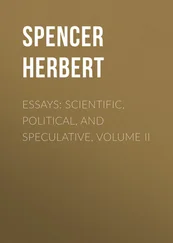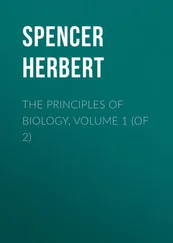The origin of other totems, equally strange, if not even stranger, is similarly accounted for, though otherwise unaccountable. One of the New-Zealand chiefs claimed as his progenitor the neighbouring great mountain, Tongariro. This seemingly-whimsical belief becomes intelligible when we observe how easily it may have arisen from a nickname. Do we not ourselves sometimes speak figuratively of a tall, fat man as a mountain of flesh? And, among a people prone to speak in still more concrete terms, would it not happen that a chief, remarkable for his great bulk, would be nicknamed after the highest mountain within sight, because he towered above other men as this did above surrounding hills? Such an occurrence is not simply possible, but probable. And, if so, the confusion of metaphor with fact would originate this surprising genealogy. A notion perhaps yet more grotesque, thus receives a satisfactory interpretation. What could have put it into the imagination of any one that he was descended from the dawn? Given the extremest credulity, joined with the wildest fancy, it would still seem requisite that the ancestor should be conceived as an entity; and the dawn is entirely without that definiteness and comparative constancy which enter into the conception of an entity. But when we remember that "the Dawn" is a natural complimentary name for a beautiful girl opening into womanhood, the genesis of the idea becomes, on the above hypothesis, quite obvious. [32]
Another indirect verification is that we thus get a clear conception of Fetichism in general. Under the fetichistic mode of thought, surrounding objects and agents are regarded as having powers more or less definitely personal in their natures; and the current interpretation is, that human intelligence, in its early stages, is obliged to conceive of their powers under this form. I have myself hitherto accepted this interpretation; though always with a sense of dissatisfaction. This dissatisfaction was, I think, well grounded. The theory is scarcely a theory properly so-called; but rather, a restatement in other words. Uncivilized men do habitually form anthropomorphic conceptions of surrounding things; and this observed general fact is transformed into the theory that at first they must so conceive them—a theory for which the psychological justification attempted, seems to me inadequate. From our present stand-point, it becomes manifest that Fetichism is not primary but secondary. What has been said above almost of itself shows this. Let us, however, follow out the steps of its genesis. Respecting the Tasmanians, Dr. Milligan says:—"The names of men and women were taken from natural objects and occurrences around, as, for instance, a kangaroo, a gum tree, snow, hail, thunder, the wind," flowers in blossom, etc. Surrounding objects, then, giving origin to names of persons, and being, in the way shown, eventually mistaken for the actual progenitors of those who descend from persons nicknamed after them, it results that these surrounding objects come to be regarded as in some manner possessed of personalities like the human. He whose family tradition is that his ancestor was "the Crab," will conceive the crab as having a disguised inner power like his own; an alleged descent from "the Palm-tree" will entail belief in some kind of consciousness dwelling in the palm-tree. Hence, in proportion as the animals, plants, and inanimate objects or agents that originate names of persons, become numerous (which they will do in proportion as a tribe becomes large and the number of persons to be distinguished from one another increases), multitudinous things around will acquire imaginary personalities. And so it will happen that, as Mr. McLennan says of the Feejeeans, "Vegetables and stones, nay, even tools and weapons, pots and canoes, have souls that are immortal, and that, like the souls of men, pass on at last to Mbulu, the abode of departed spirits." Setting out, then, with a belief in the still-living other self of the dead ancestor, the alleged general cause of misapprehension affords us an intelligible origin of the fetichistic conception; and we are enabled to see how it tends to become a general, if not a universal, conception.
Other apparently inexplicable phenomena are at the same time divested of their strangeness. I refer to the beliefs in, and worship of, compound monsters—impossible hybrid animals, and forms that are half human, half brutal. The theory of a primordial Fetichism, supposing it otherwise adequate, yields no feasible solutions of these. Grant the alleged original tendency to think of all natural agencies as in some way personal. Grant, too, that hence may arise a worship of animals, plants, and even inanimate bodies. Still the obvious implication is that the worship so derived will be limited to things that are, or have been, perceived. Why should this mode of thought lead the savage to imagine a combination of bird and mammal; and not only to imagine it, but to worship it as a god? If even we admit that some illusion may have suggested the belief in a creature half man, half fish, we cannot thus explain the prevalence among Eastern races of idols representing bird-headed men, and men having their legs replaced by the legs of a cock, and men with the heads of elephants.
Carrying with us the inferences above drawn, however, it is a corollary that ideas and practices of these kinds will arise. When tradition preserves both lines of ancestry—when a chief, nicknamed "the Wolf", carries away from an adjacent tribe a wife who is remembered either under the animal name of her tribe, or as a woman; it will happen that if a son distinguishes himself, the remembrance of him among his descendants will be that he was born of a wolf and some other animal, or of a wolf and a woman. Misinterpretation, arising in the way described from defects of language, will entail belief in a creature uniting the attributes of the two; and if the tribe grows into a society, representations of such a creature will become objects of worship. One of the cases cited by Mr. McLennan may here be repeated in illustration. "The story of the origin of the Dikokamenni Kirgheez," they say, "from a red greyhound and a certain queen and her forty handmaidens, is of ancient date." Now, if "the red greyhound" was the nickname of a man extremely swift of foot (celebrated runners have been nicknamed "greyhound" among ourselves), a story of this kind would naturally arise; and if the metaphorical name was mistaken for the actual name, there might result, as the idol of the race, a compound form appropriate to the story. We need not be surprised, then, at finding among the Egyptians the goddess Pasht represented as a woman with a lion's head, and the god Har-hat as a man with the head of a hawk. The Babylonian gods—one having the form of a man with an eagle's tail, and another uniting a human bust to a fish's body—no longer appear such unaccountable conceptions. We get feasible explanations, too, of sculptures representing sphinxes, winged human-headed bulls, etc.; as well as of the stories about centaurs, satyrs, and the rest.
Ancient myths in general thus acquire meanings considerably different from those ascribed to them by comparative mythologists. Though these last may be in part correct, yet if the foregoing argument is valid, they can scarcely be correct in their main outlines. Indeed, if we read the facts the other way upward, regarding as secondary or additional, the elements that are said to be primary, while we regard as primary, certain elements which are considered as accretions of later times, we shall, I think, be nearer the truth.
The current theory of the myth is that it has grown out of the habit of symbolizing natural agents and processes, in terms of human personalities and actions. Now, it may in the first place be remarked that, though symbolization of this kind is common among civilized races, it is not common among races that are the most uncivilized. By existing savages, surrounding objects, motions, and changes, are habitually used to convey ideas respecting human transactions. It needs but to read the speech of an Indian chief to see that just as primitive men name one another metaphorically after surrounding objects, so do they metaphorically describe one another's doings as though they were the doings of natural objects. But assuming a contrary habit of thought to be the dominant one, ancient myths are explained as results of the primitive tendency to symbolize inanimate things and their changes, by human beings and their doings.
Читать дальше












